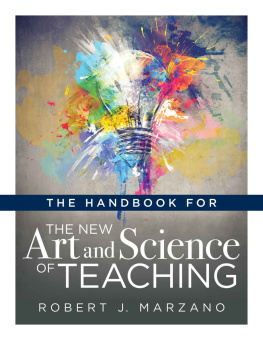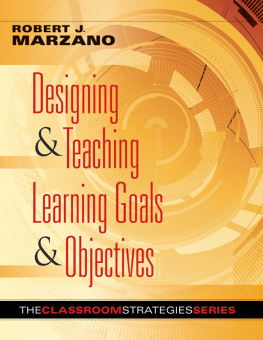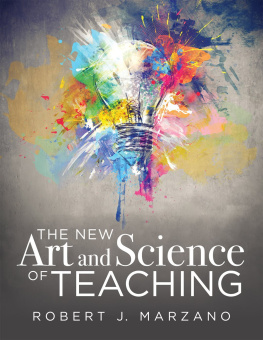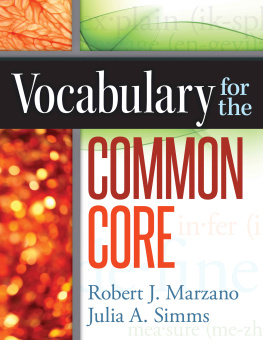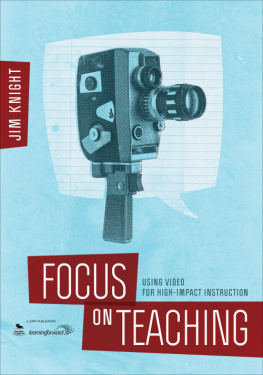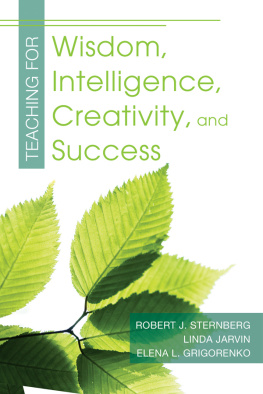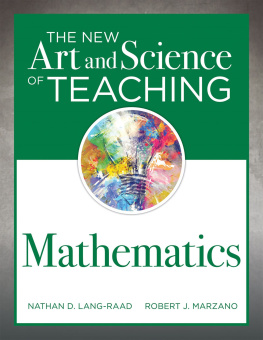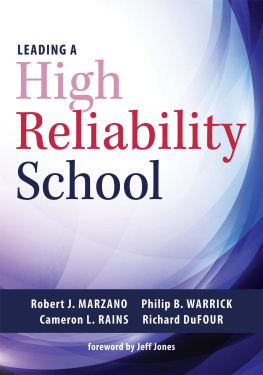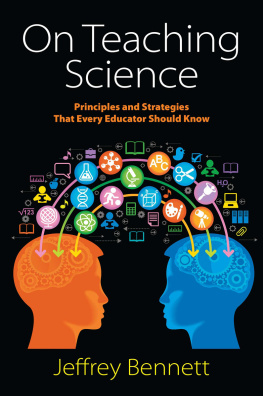
THE HANDBOOK FOR
THE NEW
Art and Science
OF TEACHING
ROBERT J. MARZANO

Copyright 2019 by Solution Tree Press
Materials appearing here are copyrighted. With one exception, all rights are reserved. Readers may reproduce only those pages marked Reproducible. Otherwise, no part of this book may be reproduced or transmitted in any form or by any means (electronic, photocopying, recording, or otherwise) without prior written permission of the publisher.
555 North Morton Street
Bloomington, IN 47404
800.733.6786 (toll free) / 812.336.7700
FAX: 812.336.7790
email:
SolutionTree.com
Visit go.SolutionTree.com/instruction to download the free reproducibles in this book.
Printed in the United States of America

Library of Congress Cataloging-in-Publication Data
Names: Marzano, Robert J., author. | Marzano, Robert J. New art and science of teaching.
Title: The handbook for the new art and science of teaching / Robert J. Marzano.
Description: Bloomington, IN : Solution Tree Press, [2019] | Companion volume to The new art and science of teaching. | Includes bibliographical references and index.
Identifiers: LCCN 2018014071 | ISBN 9781947604315 (perfect bound)
Subjects: LCSH: Effective teaching--United States. | Classroom management--United States. | Teaching--Aids and devices. | Learning, Psychology of.
Classification: LCC LB1025.3 .M3424 2019 | DDC 371.102--dc23 LC record available at https://lccn.loc.gov/2018014071
Solution Tree
Jeffrey C. Jones, CEO
Edmund M. Ackerman, President
Solution Tree Press
President and Publisher: Douglas M. Rife
Editorial Director: Sarah Payne-Mills
Art Director: Rian Anderson
Managing Production Editor: Kendra Slayton
Senior Production Editor: Suzanne Kraszewski
Senior Editor: Amy Rubenstein
Proofreader: Miranda Addonizio
Text and Cover Designer: Laura Cox
Editorial Assistant: Sarah Ludwig
Visit go.SolutionTree.com/instruction to download the free reproducibles in this book.

Table of Contents
Reproducibles are in italics.

About the Author

Robert J. Marzano, PhD, is the cofounder and chief academic officer of Marzano Research in Denver, Colorado. During his fifty years in the field of education, he has worked with educators as a speaker and trainer and has authored more than forty books and two hundred articles on topics such as instruction, assessment, writing and implementing standards, cognition, effective leadership, and school intervention. His books include The New Art and Science of Teaching, Leaders of Learning, Making Classroom Assessments Reliable and Valid, A Handbook for Personalized Competency-Based Education, and Teacher Evaluation That Makes a Difference. His practical translations of the most current research and theory into classroom strategies are known internationally and are widely practiced by both teachers and administrators.
Dr. Marzano received a bachelors degree from Iona College in New York, a masters degree from Seattle University, and a doctorate from the University of Washington.
To learn more about Robert J. Marzanos work, visit marzanoresearch.com.

Introduction
The New Art and Science of Teaching has a long history, dating back to the 1980s, when my colleagues and I synthesized the research and theory that would become the foundation for this book. In the ensuing years, my colleagues and I developed texts that explored research-supported instructional strategiesnamely, Dimensions of Thinking (Marzano et al., 1988) and A Different Kind of Classroom (Marzano, 1992). However, some believed that the strategies themselves would guarantee enhanced student learning. As this is simply not the case, I set about to create an instructional model that would tie the strategies together in an interactive manner that would allow them to work in concert. And The Art and Science of Teaching (Marzano, 2007) was born.
As I have stated before, effective teaching is not merely following a set of preprogrammed instructional strategies. Rather, the strategies are techniques that the teacher uses to create lessons that optimize student learning. In this way, teachers are artists in using skill and savvy to develop unique creations that are not scripted but true to their individuality. And like any artist, teachers must continuously better their skill using the most up-to-date techniques based on research and theory. The New Art and Science of Teaching (Marzano, 2017) represents the current knowledge of effective teaching and draws from the past and is rooted in the present while turning an eye toward the future.
The New Art and Science of Teaching
The model of effective instruction has been updated in several ways. I have added two categories ([1] Strategies That Appear in All Types of Lessons and [2] Assessment) and arranged the categories into three overarching segments: (1) feedback, (2) content, and (3) context. Feedback refers to the information loop between the teacher and the students that provides students with an awareness of what they should be learning and how they are doing. Content refers to lesson progression, which allows students to move from an initial understanding of context to application of content while continuously reviewing and upgrading their knowledge. Context refers to the following student psychological needs: engagement, order, a sense of belonging, and high expectations.
Additionally, I have rearranged some of the elements that appear in each design area to eliminate redundancy and added some new elements. As an example of rearrangement to eliminate redundancy, the element of organizing students to interact (now in the category Strategies That Appear in All Types of Lessons) is a combination of three separate content-related elements from the original framework: (1) organizing students to interact with new knowledge, (2) organizing students to practice and deepen knowledge, and (3) organizing students for cognitively complex tasks. New elements include generating and defending claims, motivating and inspiring students, and both elements within the Assessment category. The model now encompasses 43 elements and 332 strategies.
Perhaps the greatest change to the model is that it takes a student-outcomes perspective as opposed to the teacher-outcomes perspective of The Art and Science of Teaching. This focus on student outcomes makes intuitive sense since the instructional strategies are meant to generate certain mental states and processes in students minds to thus enhance their learning. depicts these specific mental states and processes.
Next page
